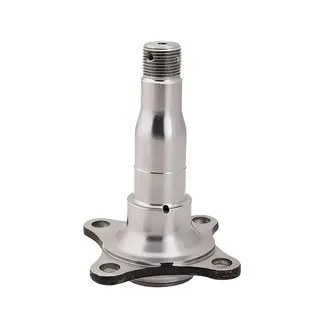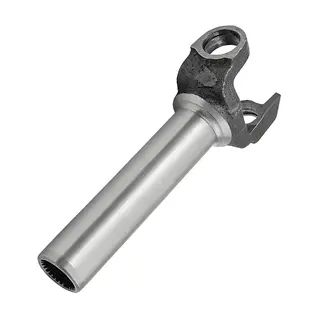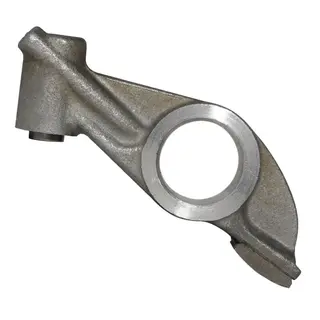In the field of metal processing, forging is a crucial process. It applies external force to cause plastic deformation of metal materials, thereby obtaining the required shape and performance. According to different temperature conditions, forging processes are mainly divided into cold forging, warm forging, and hot forging. This article will deeply explore cold forging and hot forging, the two most common forging processes, analyze their characteristics, advantages and disadvantages, as well as applicable scenarios, to help readers fully understand these two forging processes.
Forging is a processing method that uses forging machinery to apply pressure to metal billets, causing them to undergo plastic deformation, thereby obtaining forgings with certain shapes, dimensions, and properties. Forging not only changes the shape of the metal but also optimizes its internal structural organization, improving the mechanical properties of the material. According to the temperature state of the metal during the forging process, forging processes can be divided into cold forging, warm forging, and hot forging.
Cold forging, as the name suggests, is a forging process that carries out pressure processing of metal materials at room temperature. This process does not require heating treatment of the metal and directly performs processing at normal temperature.
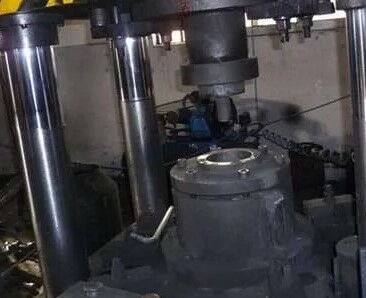
Excellent surface quality: Since the metal material is not heated during cold forging, no oxide scale is generated, and the surface smoothness of the forging is better. This makes cold forgings more attractive in appearance, and no additional surface treatment process is required, reducing production costs.
High dimensional accuracy: Cold forging can achieve higher dimensional accuracy. During the process, the deformation resistance of the metal material is relatively large, making the shape and dimensions of the forgings more stable, with less likelihood of deformation or dimensional deviation.
Work hardening effect: During cold forging, the metal material undergoes work hardening, meaning the strength and hardness of the material increase with processing. This work hardening effect can enhance the mechanical properties of the forgings, making them more wear-resistant and fatigue-resistant in subsequent use.
Controllable metal fiber flow direction: Cold forging can give the metal fiber flow a specific orientation. This orientation optimizes the mechanical properties of the material, providing better strength and toughness in specific directions to meet the needs of different application scenarios.
Cold forging is suitable for metals with relatively small deformation resistance and good plasticity at room temperature, such as aluminum and some alloys, copper and some alloys, low-carbon steel, medium-carbon steel, and low-alloy structural steel. These materials can better adapt to deformation during cold forging, achieving the desired forging shape and performance.
Cold forging is widely used in the mass production of parts for automobiles and general machinery. For example, key parts such as crankshafts and connecting rods of automobile engines, as well as various precision mechanical parts such as gears and bearings, are often produced by cold forging. These parts require high dimensional accuracy and surface quality, which cold forging can provide, while also improving production efficiency and reducing production costs.
Despite its many advantages, cold forging also has certain limitations:
Reduced plasticity and toughness of material: The work hardening effect generated during cold forging, although increasing the strength and hardness of the material, may also reduce its plasticity and toughness. This may adversely affect subsequent processing and use, especially in applications requiring further machining or withstanding large impact loads.
High deformation force requirement: Since the deformation resistance of metals during cold forging is high, greater deformation force is required. This demands higher tonnage and stronger load capacity of equipment, increasing equipment investment and operating costs.
Internal residual stress: Residual stress may be generated inside the metal during cold forging. This may affect dimensional stability of the forgings, causing deformation or cracks during subsequent use. Therefore, appropriate heat treatment is usually required after cold forging to eliminate residual stress and ensure forging quality and performance.
High requirements for molds: Cold forging demands high precision and strength for molds. As large deformation forces are applied, molds must have sufficient strength and wear resistance to withstand high stresses and friction. In addition, mold dimensional accuracy directly affects forging dimensional accuracy and surface quality, requiring high-precision mold manufacturing processes.
Hot forging is a forging process where metal materials are heated above the recrystallization temperature but below the solidus temperature and then subjected to pressure processing.
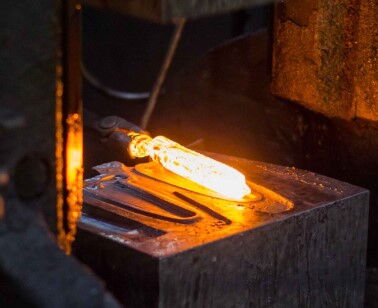
Grain coarsening and improved fracture toughness: During hot forging, the metal material is processed at high temperatures, and grains have more time to grow, forming coarser grains. This coarse-grain structure can increase the fracture toughness of the material, reduce crack propagation rates, and thus improve crack resistance.
Danger of high-temperature operation: Since hot forging is carried out at high temperatures, there are significant safety risks for both personnel and materials. High-temperature operations may cause burns or scalds, while metal materials at high temperatures are prone to oxidation, producing oxide scale that affects the surface quality and smoothness of forgings.
Oxide scale problem: During hot forging, metal materials easily oxidize at high temperatures, generating oxide scale. Oxide scale attaches to the surface of forgings, causing surface fouling, reducing smoothness and flatness. In later processing and use, oxide scale may peel off, affecting product quality and performance.
Cooling shrinkage phenomenon: After hot forging is completed, cooling shrinkage occurs during cooling of the material, possibly affecting dimensional accuracy. Therefore, precise control of forging dimensions is required in hot forging production to meet design requirements.
Hot forging is suitable for various metal materials, especially those with high deformation resistance and poor plasticity at room temperature. Heating reduces deformation resistance, making plastic deformation easier. Hot forging is widely used in the production of large forgings, such as hull structural parts of large ships and gears, shafts of large machinery, etc. These parts usually require large sizes and high strength, which hot forging can provide while also improving production efficiency.
Hot forging has certain advantages but also some limitations:
High-temperature oxidation and surface quality: Oxidation of metals during hot forging is a major challenge. Oxide scale affects forging appearance quality and may lead to performance decline in later processing and use. Protective measures, such as protective gas or coatings during heating, are required to reduce oxidation.
High equipment and maintenance cost: Hot forging requires high-temperature heating equipment, which is usually complex and costly. Moreover, high-temperature operations demand high maintenance and servicing of equipment, requiring regular inspection and repair to ensure normal operation. This increases production cost and management difficulty.
Production efficiency and energy consumption: Hot forging requires heating of metals, increasing energy consumption and possibly affecting production efficiency. Heating takes time, and temperature must be precisely controlled, which may extend production cycles and reduce efficiency.
Environmental and safety issues: High-temperature operations in hot forging pose risks to environment and worker safety. Energy waste and environmental pollution may occur, while personnel safety protection requirements increase costs and management challenges.
Warm forging is a forging process between cold forging and hot forging, where the metal material’s temperature lies between the two. Warm forging combines the advantages of cold forging and hot forging, offering certain benefits.
Surface quality and dimensional accuracy: Warm forging can achieve good surface quality and dimensional accuracy while avoiding the oxide scale issue of hot forging. As the temperature is relatively low, oxidation is less severe, ensuring better surface quality. Deformation resistance is lower, enabling higher dimensional accuracy.
Grain refinement and performance optimization: Grain growth is slower due to relatively low temperatures, producing fine-grain structures. This enhances material strength and toughness, optimizing mechanical properties.
Equipment and cost advantages: Warm forging does not require high-temperature heating like hot forging, thus equipment requirements, investment, and operation costs are relatively lower. Mold requirements are also lower, reducing mold manufacturing and maintenance costs.
Warm forging is widely used in producing parts requiring high surface quality and dimensional accuracy, such as engine cylinder blocks and cylinder heads. These parts need high precision and surface quality along with strength and toughness, which warm forging can provide.
Cold forging and hot forging, as two main forging processes, each have unique advantages and limitations. They differ significantly in work hardness, pressure demand, process principle, and application scenarios.
Cold forging has harder working hardness during forming, while hot forging has softer working hardness. This is because metals resist deformation more at room temperature in cold forging, requiring greater force; in hot forging, resistance decreases, requiring less force.
Cold forging requires large pressure during molding, while hot forging requires relatively smaller pressure due to reduced deformation resistance at high temperature.
Cold forging refers to molding and reshaping metals at room temperature by rolling and forging without heating. Hot forging requires heating metals to deformation temperatures, reducing hardness and making plastic deformation easier, typically above 1000°C.
Cold forging is particularly suitable for mass production and can be used as net-shape forming. It is widely used in transportation, aerospace, and machine tool industries. Hot forging is widely used in large forgings, such as hull structures of ships and gears, shafts of large machinery, etc.
Cold forging and hot forging are two common forging processes, each with its own characteristics and application scenarios. Cold forging offers excellent surface quality, high dimensional accuracy, and significant work hardening effects, but suffers from reduced plasticity and toughness, high deformation force requirements, and residual stress issues. Hot forging provides grain coarsening with improved fracture toughness, but faces challenges of high-temperature safety risks, oxide scale, and cooling shrinkage. Warm forging combines the advantages of both, with certain strengths, making it suitable for producing parts requiring high surface quality and accuracy.
In actual production, selecting an appropriate forging process requires comprehensive consideration of material characteristics, product requirements, production cost, and equipment conditions. Through reasonable process selection, production efficiency can be improved, costs reduced, and product quality and performance ensured.

